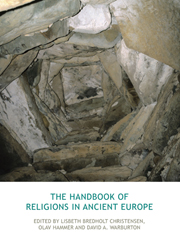Book contents
- Frontmatter
- Contents
- A note on Greek and Latin sources
- Abbreviations and short titles
- 1 Introduction
- PART I PREHISTORIC RELIGIONS
- PART II ANCIENT EUROPE IN THE HISTORICAL PERIOD
- 12 Minoan and Mycenaean religion
- 13 Etruscan religion
- 14 The religions of the Iberian Peninsula
- 15 Italic religion
- 16 Roman religion
- 17 Ancient Greek religion
- 18 The Graeco-Roman cult of Isis
- 19 The cult of Mithras
- 20 Religious Platonism: philosophy and religion in the Platonic tradition
- 21 Insular Celtic religion
- 22 Continental Germanic religion
- 23 Pre-Christian Anglo-Saxon religion
- 24 Old Norse religion
- 25 Slavic religion
- 26 Baltic religion
- 27 Religion in prehistoric Finland
- 28 Sami religion
- Timeline of key dates
- Contributors
- References
- Index
14 - The religions of the Iberian Peninsula
from PART II - ANCIENT EUROPE IN THE HISTORICAL PERIOD
- Frontmatter
- Contents
- A note on Greek and Latin sources
- Abbreviations and short titles
- 1 Introduction
- PART I PREHISTORIC RELIGIONS
- PART II ANCIENT EUROPE IN THE HISTORICAL PERIOD
- 12 Minoan and Mycenaean religion
- 13 Etruscan religion
- 14 The religions of the Iberian Peninsula
- 15 Italic religion
- 16 Roman religion
- 17 Ancient Greek religion
- 18 The Graeco-Roman cult of Isis
- 19 The cult of Mithras
- 20 Religious Platonism: philosophy and religion in the Platonic tradition
- 21 Insular Celtic religion
- 22 Continental Germanic religion
- 23 Pre-Christian Anglo-Saxon religion
- 24 Old Norse religion
- 25 Slavic religion
- 26 Baltic religion
- 27 Religion in prehistoric Finland
- 28 Sami religion
- Timeline of key dates
- Contributors
- References
- Index
Summary
Together with language, religion is one of the most common criteria used by authors of classical antiquity for establishing ethnicity, as Pliny the Elder asserted with reference to the populations of the so-called Baeturia celtica, a region which was south of the river Guadiana: Celticos a Celtiberis ex Lusitania advenisse manifestum est sacris, lingua, oppidorum vocabulis (Naturalis historia [Natural History] 3.13): “These are the Celtici who descended from Celtiberians out of Lusitania, as their religion, their language and the names of their cities demonstrated.” Yet, by nature, religion is an elusive phenomenon and, in general, we only have a very minimal knowledge of the religious systems of the peoples of the Iberian Peninsula because these peoples did not use writing in pre-Roman times to communicate with their gods in a fashion which allows much specific interpretation, nor are their rituals and doctrines preserved in writing.
When the main Mediterranean powers – Carthage and particularly Rome (third c. BCE) – intervened in the peninsula, there were two major linguistic zones: a zone inhabited by tribes who did not speak Indo-European languages, known as “Iberians”, which extended along the coast from lower Andalusia to Languedoc and inland as far as the mid-Ebro valley, and another zone inhabited by Indo-European tribes in the interior of the peninsula, where at least two languages have been attested: Lusitanian in the west and Hispano-Celtic in the two plateaus and Celtiberia (Fig. 14.1).
- Type
- Chapter
- Information
- The Handbook of Religions in Ancient Europe , pp. 156 - 172Publisher: Acumen PublishingPrint publication year: 2013



